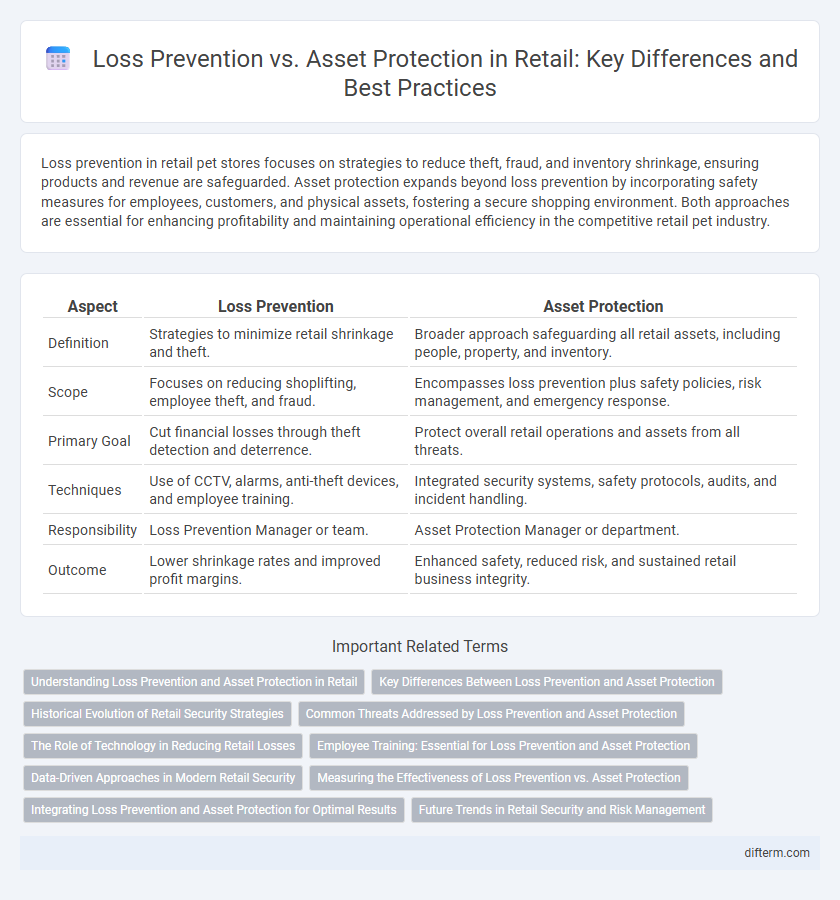Loss prevention in retail pet stores focuses on strategies to reduce theft, fraud, and inventory shrinkage, ensuring products and revenue are safeguarded. Asset protection expands beyond loss prevention by incorporating safety measures for employees, customers, and physical assets, fostering a secure shopping environment. Both approaches are essential for enhancing profitability and maintaining operational efficiency in the competitive retail pet industry.
Table of Comparison
| Aspect | Loss Prevention | Asset Protection |
|---|---|---|
| Definition | Strategies to minimize retail shrinkage and theft. | Broader approach safeguarding all retail assets, including people, property, and inventory. |
| Scope | Focuses on reducing shoplifting, employee theft, and fraud. | Encompasses loss prevention plus safety policies, risk management, and emergency response. |
| Primary Goal | Cut financial losses through theft detection and deterrence. | Protect overall retail operations and assets from all threats. |
| Techniques | Use of CCTV, alarms, anti-theft devices, and employee training. | Integrated security systems, safety protocols, audits, and incident handling. |
| Responsibility | Loss Prevention Manager or team. | Asset Protection Manager or department. |
| Outcome | Lower shrinkage rates and improved profit margins. | Enhanced safety, reduced risk, and sustained retail business integrity. |
Understanding Loss Prevention and Asset Protection in Retail
Loss prevention in retail focuses on strategies and techniques to reduce theft, fraud, and operational errors that directly impact profits. Asset protection encompasses broader measures to safeguard physical inventory, employee safety, and store assets through surveillance, training, and policy enforcement. Understanding these roles helps retailers implement effective systems to minimize shrinkage and enhance overall store security.
Key Differences Between Loss Prevention and Asset Protection
Loss prevention focuses on identifying and reducing theft, fraud, and operational errors to minimize financial losses, while asset protection encompasses broader strategies including physical security measures and employee safety to safeguard all company resources. Loss prevention primarily targets internal and external theft through investigative and surveillance techniques, whereas asset protection integrates risk management practices such as policy enforcement and emergency preparedness. Understanding key differences ensures optimized retail security by balancing immediate loss control with comprehensive asset safeguarding.
Historical Evolution of Retail Security Strategies
Retail security strategies have evolved from basic loss prevention techniques focusing on theft reduction to comprehensive asset protection systems encompassing inventory management, employee training, and technology integration. Early loss prevention centered on shoplifting deterrence using physical barriers and audits, while modern asset protection employs data analytics, surveillance cameras, and RFID technology to prevent both external and internal theft. The historical shift reflects the growing complexity of retail operations and the need for holistic solutions safeguarding financial and physical assets.
Common Threats Addressed by Loss Prevention and Asset Protection
Loss prevention and asset protection both address common retail threats such as shoplifting, employee theft, and inventory shrinkage to safeguard company assets. They employ surveillance systems, employee training, and security protocols to reduce risks from external and internal sources. Effective strategies also target organized retail crime and return fraud, minimizing financial losses across retail operations.
The Role of Technology in Reducing Retail Losses
Technology plays a critical role in retail loss prevention by enabling real-time monitoring through advanced surveillance systems and AI-driven analytics that detect suspicious behaviors and prevent theft. Asset protection strategies leverage electronic article surveillance (EAS) tags, RFID tracking, and data integration to minimize shrinkage and improve inventory accuracy. The implementation of machine learning algorithms and predictive analytics further enhances risk assessment, allowing retailers to proactively address potential losses before they escalate.
Employee Training: Essential for Loss Prevention and Asset Protection
Employee training is crucial for effective loss prevention and asset protection in retail, equipping staff with skills to identify theft risks and respond to suspicious behaviors. Comprehensive training programs improve awareness of inventory management, security protocols, and reporting procedures, reducing shrinkage and enhancing overall store safety. Regular refreshers foster a culture of vigilance, ensuring employees stay informed about evolving threats and company policies.
Data-Driven Approaches in Modern Retail Security
Loss prevention and asset protection in modern retail security increasingly rely on data-driven approaches, leveraging advanced analytics and AI-powered surveillance to identify theft patterns and high-risk behaviors. Real-time transaction monitoring and inventory tracking utilize big data to pinpoint discrepancies and potential fraud, enhancing proactive risk mitigation. Retailers integrating machine learning algorithms into their security systems achieve higher accuracy in threat detection, reducing shrinkage and improving overall operational efficiency.
Measuring the Effectiveness of Loss Prevention vs. Asset Protection
Measuring the effectiveness of loss prevention involves analyzing shrinkage rates, incident reports, and return on investment from security initiatives, focusing on reducing theft and fraud. Asset protection effectiveness is assessed through tracking inventory accuracy, equipment maintenance costs, and the stability of physical assets to ensure operational continuity. Both approaches require integrating data analytics and key performance indicators to optimize retail security and minimize financial losses.
Integrating Loss Prevention and Asset Protection for Optimal Results
Integrating loss prevention and asset protection strategies enhances retail security by combining real-time monitoring, employee training, and advanced analytics to reduce shrinkage effectively. Leveraging data-driven insights and cross-departmental collaboration maximizes operational efficiency and strengthens theft deterrence. Retailers adopting unified loss prevention and asset protection practices experience improved inventory accuracy, reduced operational costs, and increased overall profitability.
Future Trends in Retail Security and Risk Management
Emerging technologies such as AI-powered analytics and IoT sensors are revolutionizing loss prevention and asset protection by enabling real-time monitoring and predictive risk assessment in retail environments. Integration of blockchain for secure supply chain tracking enhances transparency and reduces shrinkage, while advanced video analytics improve detection of suspicious activities and employee fraud. The future of retail security emphasizes proactive, data-driven strategies that minimize losses and safeguard assets through comprehensive risk management platforms.
Loss Prevention vs Asset Protection Infographic

 difterm.com
difterm.com